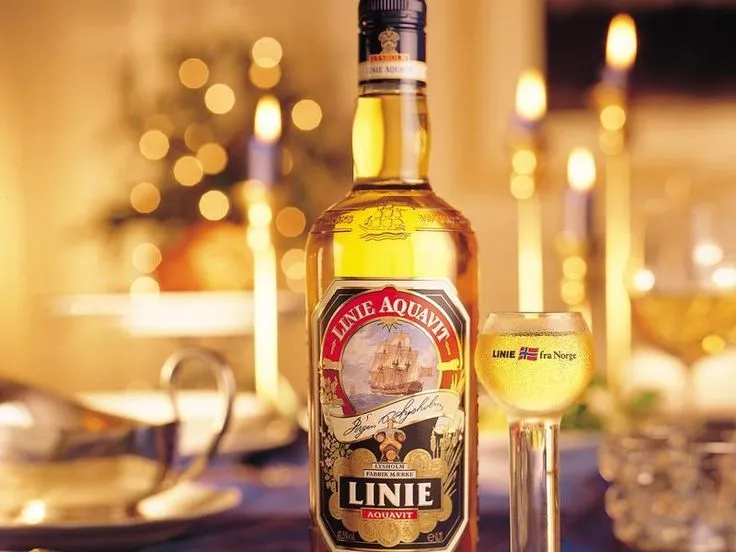Аквавит — крепкий алкогольный напиток, традиционный для Норвегии, Швеции и Дании. Его крепость обычно составляет от 37 до 45 процентов. Его готовят из зернового или картофельного спирта, настоянного на травах и специях, в основном тмине или укропе. Название происходит от латинского aqua vitae — «вода жизни». Первые упоминания относятся к XV веку, когда напиток использовался в качестве лекарства.
История и культурное значение
Аквавит появился, когда северяне искали способы поддержания здоровья в суровом климате. В 1531 году норвежский архиепископ Улав Энгельбректссон отправил в Копенгаген бочку с напитком, утверждая, что он способен излечить «все болезни». Со временем аквавит стал неотъемлемой частью праздничного стола, особенно на Рождество, Пасху и национальные праздники.
В XIX веке в Норвегии появилась традиция выдержки аквавита в дубовых бочках, которые перевозили по морю в теплые страны и обратно. Считалось, что качалка, перепады температур и влажность придавали напитку особый вкус. Так появился знаменитый «Linie Aquavit», дважды пересекший экватор за время своего путешествия.
Факты и цифры
– Крепость: 37–45%
– Основные специи: тмин, укроп, кориандр, анис, фенхель
– Срок выдержки: от нескольких месяцев до нескольких лет
– В Норвегии ежегодно выпивают более 4 миллионов литров аквавита
– Linie Aquavit путешествует около 4 месяцев и преодолевает более 35 000 километров
Похожие истории
Одна из легенд гласит, что аквавит помогал морякам пережить длительные плавания, согревая их в холодных широтах. В Швеции существует традиция петь особые песни – «snapsvisor» – перед тем, как выпить рюмку аквавита. В Дании этот напиток часто подают на рождественский стол с маринованной сельдью и ржаным хлебом.
Туристические места, связанные с аквавитом
– Осло, Норвегия – Музей аквавита Arcus, где можно узнать о производстве, истории и попробовать различные сорта.
– Тронхейм, Норвегия – исторический порт, из которого отправлялись корабли с бочками Linie Aquavit.
– Ольборг, Дания – город, известный брендом Aalborg Akvavit с дегустационными залами и гастрономическими турами.
– Гётеборг, Швеция – рестораны, где аквавит подают к традиционным блюдам Западной Швеции.
– Берген, Норвегия – фестивали, где аквавит сочетают с блюдами из морепродуктов.
Популярные бренды аквавита
– Linie Aquavit (Норвегия) – Известен своим процессом выдержки «line voyage», в ходе которого бочки дважды пересекают экватор, приобретая мягкий, дубовый и пряный вкус.
– O.P. Anderson (Швеция) – Классический шведский аквавит с тмином, анисом и фенхелем; незаменимый напиток на праздничном столе.
– Aalborg Akvavit (Дания) – Культовый датский бренд с несколькими вариациями, от настоянных на укропе до рождественских.
– Bareksten Botanical Aquavit (Норвегия) – Современный крафтовый напиток с богатым букетом скандинавских трав и специй.
– Løiten Linie (Норвегия) – Традиционный выдержанный в дубовых бочках аквавит с тёплым, пряным характером.
– Brennivín (Исландия) – Известный как «Чёрная смерть», этот исландский аквавит отличается насыщенным травянистым вкусом и часто сочетается с ферментированным мясом акулы.
– Krogstad Aquavit (США) – Американская интерпретация со скандинавскими растительными компонентами, популярная в коктейлях.
– Tattersall Aquavit (США) – Сделано в Миннесоте, яркий и цитрусовый с традиционными нотками тмина.
Как пить аквавит
– Температура: Традиционно подаётся охлаждённым (около 6–8 °C) в небольших бокалах. Выдержанные сорта можно пить при комнатной температуре, чтобы насладиться ароматом.
– Бокалы: Бокалы в форме тюльпана или бокалы-кордиал концентрируют аромат; стопки обычно используются для праздничных тостов.
– В чистом виде: Пейте медленно, чтобы насладиться многогранностью травяного вкуса.
– С едой: Идеально сочетается с маринованной сельдью, копчёным лососем, вяленым мясом, острыми сырами и ржаным хлебом.
– В коктейлях: Хорошо сочетается с мартини, негрони или тоником с цитрусовыми, создавая скандинавский колорит.
– Ритуалы: В Скандинавии принято смотреть друг другу в глаза, говорить «Skål!» и иногда петь короткую застольную песню перед глотком.
Ценовой диапазон (доллары США)
– Бренды начального уровня (O.P. Anderson, Aalborg) – 20–30 долларов за 700–750 мл
– Классические водки, выдержанные в море (Linie Aquavit) – 32–40 долларов за 750 мл
– Премиальные крафтовые водки (Bareksten, Løiten Linie) – 45–70 долларов за 700–750 мл
– Специальные издания и выдержанные в винных бочках – 70–120 долларов и более в зависимости от редкости
– Элитные и коллекционные напитки – 150–300 долларов и более за лимитированные выпуски
- Brest (Belarus)
- Africa
- Madagaskar
- Pakistan
- Gibraltar
- Irkutsk
- Germany
- Macau
- Wrangel Island
- Sumatra
- Colombia
- Мошенничество с Istanbulkart: чего следует остерегаться туристам
- Moab
- Georgia
- Lifehacks for buying airline tickets
- Saami
- Чаепитие в 5‑звездочном отеле Mount Nelson в Кейптауне
- Los Angeles
- Mongolia
- Falkland Islands

 Hong Kong
Hong Kong